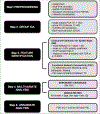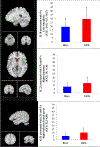Adolescent sex differences in cortico-subcortical functional connectivity during response inhibition
- PMID: 31111341
- PMCID: PMC8259338
- DOI: 10.3758/s13415-019-00718-y
Adolescent sex differences in cortico-subcortical functional connectivity during response inhibition
Abstract
Numerous lines of evidence have shown that cognitive processes engaged during response inhibition tasks are associated with structure and functional integration of regions within fronto-parietal networks. However, while prior studies have started to characterize how intrinsic connectivity during resting state differs between boys and girls, comparatively less is known about how functional connectivity differs between males and females when brain function is exogenously driven by the processing demands of typical Go/No-Go tasks that assess both response inhibition and error processing. The purpose of this study was to characterize adolescent sex differences and possible changes in sexually dimorphic regional functional connectivity across adolescent development in both cortical and subcortical brain connectivity elicited during a visual Go/No-Go task. A total of 130 healthy adolescents (ages 12-25 years) performed a Go/No-Go task during functional magnetic resonance imaging. High model-order group independent component analysis was used to characterize whole-brain network functional connectivity during response inhibition and then a univariate technique used to evaluate differences related to sex and age. As predicted and similar to previously described findings from non-task-driven resting state connectivity studies, functional connectivity sex differences were observed in several subcortical regions, including the amygdala, caudate, thalamus, and cortical regions, including inferior frontal gyrus engaged most strongly during successful response inhibition and/or error processing. Importantly, adolescent boys and girls exhibited different normative profiles of age-related changes in several default mode networks of regions and anterior cingulate cortex. These results suggest that cortical-subcortical functional networks supporting response inhibition operate differently between sexes during adolescence.
Keywords: Adolescence; Functional network connectivity; Response inhibition; Sex difference.
Conflict of interest statement
Conflicts of Interest Statement
The authors declare that the research was conducted in the absence of any commercial or financial relationships that could be construed as a potential conflict of interest.
Figures





Similar articles
-
Sex differences in aberrant functional connectivity of three core networks and subcortical networks in medication-free adolescent-onset major depressive disorder.Cereb Cortex. 2024 Jun 4;34(6):bhae225. doi: 10.1093/cercor/bhae225. Cereb Cortex. 2024. PMID: 38836288
-
Aberrant "deep connectivity" in autism: A cortico-subcortical functional connectivity magnetic resonance imaging study.Autism Res. 2019 Mar;12(3):384-400. doi: 10.1002/aur.2058. Epub 2019 Jan 9. Autism Res. 2019. PMID: 30624021
-
ADHD-related sex differences in fronto-subcortical intrinsic functional connectivity and associations with delay discounting.J Neurodev Disord. 2018 Dec 13;10(1):34. doi: 10.1186/s11689-018-9254-9. J Neurodev Disord. 2018. PMID: 30541434 Free PMC article.
-
Functional brain imaging across development.Eur Child Adolesc Psychiatry. 2013 Dec;22(12):719-31. doi: 10.1007/s00787-012-0291-8. Epub 2012 Jun 24. Eur Child Adolesc Psychiatry. 2013. PMID: 22729957 Free PMC article. Review.
-
fMRI functional connectivity applied to adolescent neurodevelopment.Annu Rev Clin Psychol. 2015;11:361-77. doi: 10.1146/annurev-clinpsy-032814-112753. Epub 2015 Jan 2. Annu Rev Clin Psychol. 2015. PMID: 25581237 Free PMC article. Review.
Cited by
-
Identifying periods of heightened susceptibility to lead exposure in relation to behavioral problems.J Expo Sci Environ Epidemiol. 2022 Jan;32(1):1-9. doi: 10.1038/s41370-021-00389-3. Epub 2021 Nov 2. J Expo Sci Environ Epidemiol. 2022. PMID: 34728761 Free PMC article.
-
The right inferior frontal gyrus as pivotal node and effective regulator of the basal ganglia-thalamocortical response inhibition circuit.Psychoradiology. 2023 Oct 13;3:kkad016. doi: 10.1093/psyrad/kkad016. eCollection 2023. Psychoradiology. 2023. PMID: 38666118 Free PMC article.
-
Task-evoked functional connectivity exhibits novel and strengthened relationships with executive function relative to the resting state.bioRxiv [Preprint]. 2025 Jul 4:2025.06.30.661993. doi: 10.1101/2025.06.30.661993. bioRxiv. 2025. PMID: 40631142 Free PMC article. Preprint.
-
Short-term caloric restriction or resveratrol supplementation alters large-scale brain network connectivity in male and female rats.Front Nutr. 2025 Feb 3;12:1440373. doi: 10.3389/fnut.2025.1440373. eCollection 2025. Front Nutr. 2025. PMID: 39963669 Free PMC article.
-
Neurobehavioral maturation of motor response inhibition in adolescence - A narrative review.Neurosci Biobehav Rev. 2022 Jun;137:104646. doi: 10.1016/j.neubiorev.2022.104646. Epub 2022 Mar 30. Neurosci Biobehav Rev. 2022. PMID: 35367223 Free PMC article. Review.
References
Publication types
MeSH terms
Grants and funding
LinkOut - more resources
Full Text Sources
Medical
Research Materials

